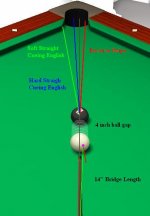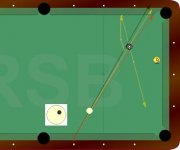I made an interesting observation, as diagrammed below.
Using Backhand English (BHE) with a 14" bridge length with CB and OB straight on, just 4" apart.
As I expected, playing with soft right english the OB threw considerably to the left, even though the 14" bridge length would have squirted the CB left of center slightly. In fact, even with a 30" bridge length, with the balls so close together the squirt is not enough to make the OB travel straight.
When the shot is played hard, as we'd suspect, throw is reduced significantly and also I believe the CB squirt is a little greater and the OB follows the blue line path.
Then I tried cueing coming to the contact point from outside the line (as shown {exaggerated} in red). The is the reverse of standard swipe, or tuck in this case. Hence I've termed it Reverse Swipe. Some might say I am using 'roll' on the shot and that would make sense too, though I'm using roll to put on right english instead of left english.
Now you may think this is a pretty unnatural stroke, but actually it feels quite natural when executed for me. In fact, I believe I have used this shot subconsciously in the past to make shots go, or to push the CB where I wanted it to go.
This Reverse Swipe significantly increases the effective squirt deflection angle, so much so that even at 4" seperation I could make the OB travel to the right of the initial target line.
I tested this by playing the same shot with 2 feet seperation and foud I could even miss the pocket to the right, so squirt is definitely the culprit.
This provides a warning for users of BHE systems that they need to be careful in executing a consistant and accurate cue action. Swiping and Reverse Swiping can change the squirt angle considerably.
It also provide as opportunity, or an extra option which can be used in 2 possible ways that I can think of at this point:
1. When bridge length is restricted such as when cueing from the rail, Reverse Swipe can be used so that original alignment will still provide a predictable result, rather than having to aim thick with OE or thin with IE when this same situation occurs.
2. A player can adapt a system of squirt = SIT cancellation system using shorter bridge lengths by varying the cue path.
Using Backhand English (BHE) with a 14" bridge length with CB and OB straight on, just 4" apart.
As I expected, playing with soft right english the OB threw considerably to the left, even though the 14" bridge length would have squirted the CB left of center slightly. In fact, even with a 30" bridge length, with the balls so close together the squirt is not enough to make the OB travel straight.
When the shot is played hard, as we'd suspect, throw is reduced significantly and also I believe the CB squirt is a little greater and the OB follows the blue line path.
Then I tried cueing coming to the contact point from outside the line (as shown {exaggerated} in red). The is the reverse of standard swipe, or tuck in this case. Hence I've termed it Reverse Swipe. Some might say I am using 'roll' on the shot and that would make sense too, though I'm using roll to put on right english instead of left english.
Now you may think this is a pretty unnatural stroke, but actually it feels quite natural when executed for me. In fact, I believe I have used this shot subconsciously in the past to make shots go, or to push the CB where I wanted it to go.
This Reverse Swipe significantly increases the effective squirt deflection angle, so much so that even at 4" seperation I could make the OB travel to the right of the initial target line.
I tested this by playing the same shot with 2 feet seperation and foud I could even miss the pocket to the right, so squirt is definitely the culprit.
This provides a warning for users of BHE systems that they need to be careful in executing a consistant and accurate cue action. Swiping and Reverse Swiping can change the squirt angle considerably.
It also provide as opportunity, or an extra option which can be used in 2 possible ways that I can think of at this point:
1. When bridge length is restricted such as when cueing from the rail, Reverse Swipe can be used so that original alignment will still provide a predictable result, rather than having to aim thick with OE or thin with IE when this same situation occurs.
2. A player can adapt a system of squirt = SIT cancellation system using shorter bridge lengths by varying the cue path.
Attachments
Last edited:

